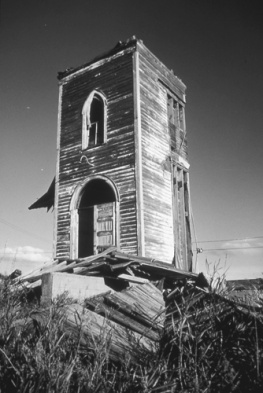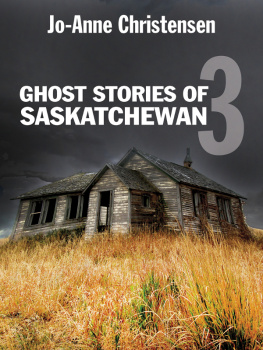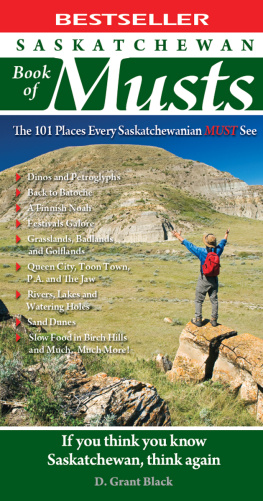About the Author
Johnnie Bachusky is a national awardwinning journalist who has explored hundreds of ghost towns across western and northern Canada since the late 1990s. He has written dozens of ghost-town and heritage-related articles for newspapers and magazines in Canada. Johnnie is also the author of Ghost Town Stories of Alberta: Abandoned Dreams in the Shadows of the Canadian Rockies and Ghost Town Stories of BC: Tales of Hope, Heroism and Tragedy . His heritage photography has been featured in national and international publications, and he has been consulted and featured in many television and film documentaries. As well, he is the co-creator of three acclaimed websites about ghost towns in Alberta, Saskatchewan and British Columbia, as well as the heritage photography site Silent Structures. His photography of pioneer wooden grain elevators is also featured on many websites, including Grain Elevators of Canada. He lives with his wife, Darlis, daughter, Darlana, and his three cats and hound in Red Deer, Alberta. And yes, in 2009 he was named Discovery Channels Canadas Worst Handyman.
Acknowledgements
The following local community history books provided me with valuable sources of information for this book: Shortgrass Country published by Foremost Historical Society; Our Side of the Hills by Reno History Book Association; From Sage to Timber by the Merry Battlers Ladies Club; Between and Beyond the Benches by Ravenscrag History Book Committee; and Next Year Country by Notukeu History Book Club.
As well, past editions of regional newspapers proved invaluable for my research, notably Reginas Leader-Post (March 18 and 19, 1940) for the prologue, The Medicine Hat News (December 1916) for the chapter on Manyberries, and The Western Producer (December 1, 1960) for the Govenlock chapter.
I also wish to extend my deep appreciation and gratitude to the many people who contributed their time and stories for this book. Because of the number of people, it is impossible for me to list everyone. However, I must extend a special thanks to Vivian Stuber, president of the Manyberries Historical Association, for her help with both the Manyberries and Orion chapters. I also thank Calgarys Don Sucha. Don and I are kindred spirits of sorts. His expertise is in the study of cemeteries. His commitment to and extraordinary help with this book are greatly appreciated. Finally, I would like to thank my late friend Geoff Payne, who I knew well in the 1990s while I worked at the Kerby Centre. After our trip to Highway 61, Geoff mentioned that some day it might be a good idea to write a book. Its done Geoff, and thank you.
As well, Id like to offer a special thank-you to Toronto web designers Susan Foster and Jeri Danyleyko, co-founders of www.ghosttownpix.com, for the support theyve given me on this project and my ongoing ghost-town journeys.
Bibliography
Anderson, Frank W. The Dynamic Crows Nest . Calgary: Frontier Publishing Ltd., 1969.
_____. Outlaws of Manitoba . Calgary: Frontier Publishing Ltd., 1971.
_____. The Rum Runners . Edmonton: Lone Pine Publishing, 1991.
Basque, Garnet, ed. Frontier Days in Alberta . Langley: Sunfire Publications Ltd., 1992.
Chatenay, Henri. The Country Doctors . Red Deer: Mattrix Press, 1980.
Knuckle, Robert. In the Line of Duty: The Honour Roll of the RCMP Since 1873 . Burnstown, ON: General Store Publishing, 1994.
MacEwan, Grant. Sitting Bull: The Years in Canada . Edmonton: Hurtig Publishers, 1973.
Moore, Frank. Saskatchewan Ghost Towns . Regina: Associated Printers, 1982.
Primrose, Tom. The Cypress Hills . Calgary: Frontier Publishing Ltd., 1969.
Russell, E.T. Whats in a Name: The Story Behind Saskatchewan Place Names , 3rd ed. Calgary: Fifth House Ltd., 1997.
Wilson, Gary A. Honky Tonk Town: Havres Bootlegging Days . Havre, MT: High-Line Books, 1985.
Contents
Copyright 2010 Johnnie Bachusky
All rights reserved. No part of this publication may be reproduced, stored in a retrieval system or transmitted in any form or by any meanselectronic, mechanical, audio recording or otherwisewithout the written permission of the publisher or a photocopying licence from Access Copyright, Toronto, Canada.
Originally published by Heritage House Publishing Co. Ltd. in 2010 in paperback with ISBN 978-1-926613-70-3.
This electronic edition was released in 2011.
e-pub ISBN: 978-1-926936-20-8
e-PDF ISBN: 978-1-926936-42-0
Cataloguing data available from Library and Archives Canada
Edited by Lesley Reynolds
Cover image of pioneer home in Manyberries, Alberta, by Johnnie Bachusky.
Heritage House acknowledges the financial support for its publishing program from the Government of Canada through the Canada Book Fund (CBF), Canada Council for the Arts and the province of British Columbia through the British Columbia Arts Council and the Book Publishing Tax Credit.

www.heritagehouse.ca

For Darlis and Darlana
EPILOGUE
Ongoing Journeys
This is not the final chapter on the pioneer communities and people of the Red Coat Trail. There are many more stories to tell, and many more yet to come.
It has been many years since Don Sucha went to Wood Mountain, and he is far from finished learning about Constable Daniel Peach Davis. Despite the doubts held by some RCMP historians, Don is satisfied that Peach did single-handedly escort well over 200 Assiniboine more than 250 kilometres to the reserves near Battleford.
During his extensive research, Don located a 19th-century Saskatchewan Herald newspaper clipping with an article headlined, BACK TO THE GRUB PILE . For Don, it confirmed Peachs story, as passed down to family members over the years.
During the past week, several hundred of the Indians who have been spending their time at the south arrived here, noted the article. They were furnished with provisions at Cypress to bring them a part of the way across the plains, and another lot was dispatched from this side to meet them. Constable Davis took charge of the first lot of provisions and had general management of the pilgrims.
The article went on to describe the tragic killing of a member of Peachs Assiniboine group by the Blackfoot during the journey. Previous historical accounts reported bitter conflicts between the two First Nations. The Herald piece described the incident in detail.
Shortly before these people [Assiniboine] left Fort Walsh, a large body of Blackfoot visited that place and held a war dance, said the article, adding that the visitors had also stolen horses during the night. In the course of the night they got hold of [an Assiniboine] and killed him. When found in the morning he was pierced with about 50 bullets. This was good evidence that he was dead and showed the Blackfoot had a grand jubilee over the occurrence.
Dons research has not confirmed whether Peachs remarkable journey began at the US border. He is still chipping away, hoping some day to stumble upon a piece of information that will confirm the truth.
Meanwhile, another Peach mystery has unfolded as a result of Dons ongoing investigation. When Don returned from his family trip to Wood Mountain, he sent a request to the National Archives in Ottawa for Peachs service record with the NWMP. When it arrived, he discovered a sad and unsettling letter in the file written to the RCMP by a Calgary man in 1960. The man said his wife had been going through some old trunks in their house and came across an old military medal that she had had since she was a child. It was a medal of service from the 1885 North-West Rebellion.











